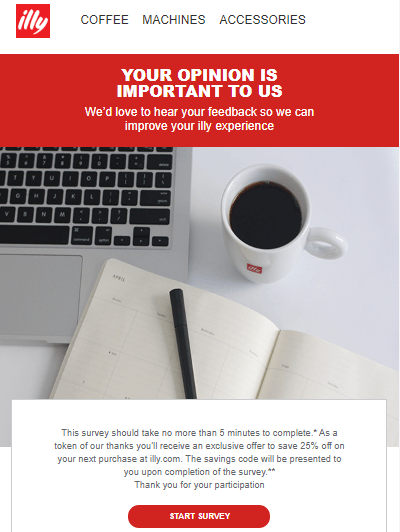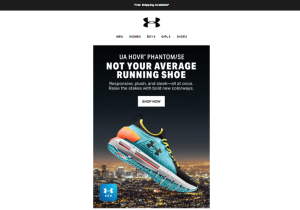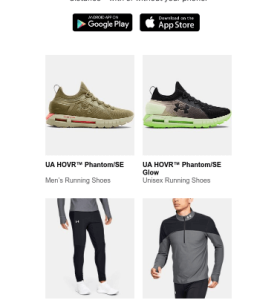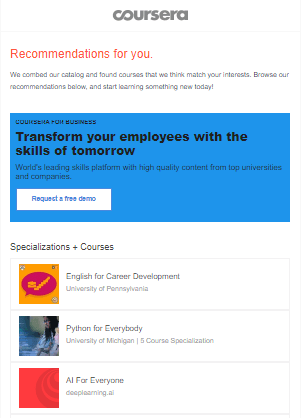Here are a couple of scenarios for you.
Situation #1.
Situation #2.
Which scenario would you prefer?
The first situation is common to all of us. We’re used to distracted discussions at coffee shops, supermarkets, and bakeries that all follow the same pattern. And what effect does it have on our customer experience?
Right. None.
The second scenario, on the other hand, makes us feel more valued and respected as clients. This is the power of customization — we are questioned about our preferences and then given tailored recommendations based on them.
The same is true for email marketing. Except when an email doesn’t thrill us, we don’t have to deal with it, like in the first case with the bakery.
This email is instantly deleted and placed in the Trash bin.
As a result, customization is the key to your subscribers’ hearts (which will also hopefully lock the door to that Trash folder).
What Do Stats Say about Email Personalization?
Campaign Monitor reports that email personalization has several significant benefits:
- emails that contain personalized offers are 26% more likely to be opened
- personalized emails have 6 times higher transaction rates
- segmented and targeted emails generate 58% of all revenue
However, for whatever reason, many businesses continue to lag behind. According to Campaign Monitor, just 39% of online businesses provide tailored offers through email.
However, email customization is vital for more than just increasing sales and improving transaction rates. Personalization, in general, is critical for providing a great customer experience and building long-term connections with customers. People like it when they are addressed by name in an email; it makes them feel special.
However, email personalization is more than just addressing a subscriber by name. There’s a lot more to it than what meets the eye.
There are email personalization strategies that perform quite well and help develop trust between a business and a consumer without disclosing any names.
What exactly are these email personalization strategies?
Let’s take a closer look.
1. What Do They Want?
Remember how, in the second example, the cashier inquired about the customer’s pastry preferences? A customer survey is an excellent personalization strategy for determining what your customers expect from your brand.
You can, however, give customers more than just involvement in improving your brand and product.
Take a look at the following email from Illy USA:

In addition to including a link to the survey, the company provides consumers who complete the survey a 25% discount on their next purchase as a show of thanks.
How does it help with consumer engagement?
This email personalization tactic works both ways.
- You will gain useful consumer insights to employ in your marketing plan, as well as ideas for emails with customized suggestions.
- Your consumers, on the other hand, receive the attention and gratitude they deserve, and such offers have an impact on their purchasing decisions since they receive a tailored offer with a discount.
As an example, if an average email survey has a response rate of 33%, adding a tailored discount offer to it is likely to quadruple this number. These emails also aid in the creation of better customer service by allowing you to understand more about your consumers and their preferences.
Furthermore, because your email is valuable, it will not be sent to the dreaded Trash bin.
2. Email Design Matters
Company leaders understand that message style is just as crucial as message content when it comes to business texting and professional text messaging.
The same is true for customized email — responsive design is just as responsible for higher email open rates as the email’s content.
What does responsive design mean for email personalization?
A responsive email:
- displays well on all devices
- adapts to all screen resolutions
- loads fast
- has all essential links
A tailored email with a decent responsive design assists a consumer in making a purchasing choice more quickly by delivering crucial information.
Here’s an example of a responsive email design from Under Armour:



How can the design of this email influence customer purchase decisions?
- It has a personalized offer, available only for subscribers.
- It provides all relevant shopping links right at the top of the email, plus, the links to the Under Armour app.
- It links subscribers to social media, where they can find more information about the brand
Even the email is quite extensive, it took us 1 second to load it on the desktop, and 2 minutes to load it on the tablet.
Personalization and responsive design go hand in hand.
According to EmailMonday, personalized and responsive emails have a 30% higher click rate. And, since people check their emails mostly from their phones, creating responsive emails is not just a whim anymore.
It’s a must.
Another difficulty is the localization of the design. Many firms that expand internationally find new audiences that have a whole different culture and speak a completely different language.
Why is email design localization important?
Customer satisfaction.
First and foremost, if you want to create a personalized approach to the new foreign audience and win them over, speak their language.
Risk reduction.
When a company enters a new foreign market, all marketing strategies as well as your entire email marketing campaign should be localized. In this case, it is recommended to hire a translation service like one of those you can find at PickWriters. Otherwise, you risk leaving out important culture- or language-related issues, which may even be offensive.
One of the first channels via which your business will be presented to a new audience is email marketing. Because you care about making your communication as comfortable as possible, responsive localized email design is already a customized approach to your readers.
3. Collect Recommendations
Emails containing strange offers typically end up in the Trash bin. Consumers, who receive hundreds of emails every day from various firms, want relevant offers that they can use.
Sending emails with suggestions is another type of email customization strategy. Coursera is an excellent example of a company that constantly recommends the best course alternatives to its customers through email:

You may be personal without addressing a customer by name by providing product suggestions targeted particularly to that subscriber. And subscribers like firms that understand their consumers’ needs and send them emails with customized offers.
Over to You
There’s an excellent proverb.
Do as you would like to be done.
You might modify that slightly: treat your clients how you would like your brand to be treated.
Building great customer relationships is critical to the success of your brand. Email marketing is one of the many tactics used by businesses nowadays.
Email marketing, on the other hand, may be unique. A basic disengaged message will elicit a low reaction rate.
Alternatively, you may develop customised emails by using user input, localized and responsive design, and personalized suggestions. And more than double your response rate.


